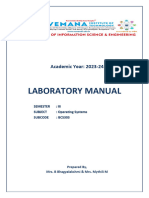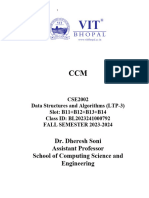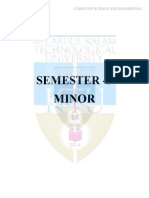0 ratings0% found this document useful (0 votes)
26 viewsModule Programming II Elins
This document summarizes an undergraduate module in Programming II offered by Universitas Gadjah Mada. The module is 3 credit points and focuses on data structures, algorithms, and object-oriented programming. Students will learn to build various linear and non-linear data structures, implement searching and sorting algorithms, and develop object-oriented computer programs. Assessment is based on exams, assignments, and exercises evaluating students' understanding of topics like data structures, algorithms, and OOP. Recommended reading materials cover related programming concepts and examples in Java, C++, and other languages.
Uploaded by
FadhlanCopyright
© © All Rights Reserved
Available Formats
Download as PDF, TXT or read online on Scribd
0 ratings0% found this document useful (0 votes)
26 viewsModule Programming II Elins
This document summarizes an undergraduate module in Programming II offered by Universitas Gadjah Mada. The module is 3 credit points and focuses on data structures, algorithms, and object-oriented programming. Students will learn to build various linear and non-linear data structures, implement searching and sorting algorithms, and develop object-oriented computer programs. Assessment is based on exams, assignments, and exercises evaluating students' understanding of topics like data structures, algorithms, and OOP. Recommended reading materials cover related programming concepts and examples in Java, C++, and other languages.
Uploaded by
FadhlanCopyright
© © All Rights Reserved
Available Formats
Download as PDF, TXT or read online on Scribd
You are on page 1/ 3
UNDERGRADUATE PROGRAM IN ELECTRONICS AND INSTRUMENTATION
DEPARTMENT OF COMPUTER SCIENCE AND ELECTRONICS
FACULTY OF MATHEMATICS AND NATURAL SCIENCES
UNIVERSITAS GADJAH MADA
Module name Programming II
Module level Undergraduate
Code MII-2201
Courses (if Programming II
applicable)
Semester Even
Contact person Yohanes Suyanto, M.Ikom., Dr.
Lecturer Yohanes Suyanto, M.Ikom., Dr.
Language Bahasa Indonesia
Relation to Undergraduate degree program; mandatory; 2nd, 4th, 6th, or 8th
curriculum semester.
Type of teaching, Undergraduate degree program: lectures, < 60 students, 180
contact hours minutes
Workload 1. Lectures: 3 x 50 = 150 minutes (2 hours 30 minutes) per week.
2. Exercises and Assignments: 3 x 60 = 180 minutes (3 hours) per
week.
3. Private study: 3 x 60 = 180 minutes (3 hours) per week.
Credit points 3 credit points (cr).
Requirements A student must have attended at least 75% of the lectures to sit in
according to the the exams.
examination
regulations
Recommended -
prerequisites
Learning outcomes After completing this module, a student is expected to:
and their
CO1 Have knowledge about the theories and concepts of PLO2
corresponding PLOs
algorithms and data structures
CO2 Be able to analyze, design, and implement linear PLO3
data structures such as linked-list, stack, and quee.
CO3 Be able to analyze, design, and implement non- PLO3
linear data structures such as matrix, hash table, multiple
linked-list, tree, and graph.
CO4 Have knowledge about searching and sorting PLO3
algorithm and can implement it in computer program.
CO5 Have knowledge about theory and concept of PLO2
object-oriented programming (OOP).
CO6 Be able to build an OOP based computer program . PLO4
Content Programming II provides the knowledge and skills required for
students to be able to:
Build data structures
Design and implement searching and sorting algorithms
Determine suitable data structures such that the
computer program generated is structured and efficient.
In this Programming II course, it focuses on the data structure,
which discusses various data structures both linear and non-linear
and looks at their strengths and weaknesses and discusses
examples of problems, and also discusses the paradigm of object
oriented programming (OOP). As new programming paradigm
developed from derived data type facilities in structured
programming, OOP provides an approach in making program
design and development in the orientation of real entities found
in the real world.
Object oriented today is a choice of programming methods that
are often used because the approach tends to be more
descriptive and well organized. Therefore, OOP becomes a topic
of discussion in the algorithm and data structure courses to
provide the development of actual programming technology to
students..
Study and Mid-terms examination and final examination.
examination
requirements and
forms of examination
Media employed LCD, whiteboard, websites, books (as references), etc.
Assessments and CO1: Problem 1 in mid-term exam (5%) and exercise 1 (5%) - 10%
Evaluation CO2: Problem 2 in mid-term exam (5%) , assignment 1 (5%), and
exercise 2 (5%) - 15%
CO3: Problem 3 in mid-term exam (10%); problem 1 in final exam
(5%); assignment 2 (5%); and exercise 3 (5%) - 25%
CO4: Problem 2 in final exam (5%) and exercise 4 (5%) - 10%
CO5: Problem 3 in final exam (10%); assignment 3 (5%); and
exercise 5 (5%) - 20%
CO6: Problem 4 in final exam (15%) and exercise 6 (5%) - 20%
Reading List WA: Data Structures and Algorithms in Java, Robert Lafore,
Second Edition, SAMS Publishing, 2003
WB: Sams Teach Yourself Data Structures and Algorithms in 24
Hours, Robert Lafore, Sams Publishing, 1999
AA: Data Structures and Algorithms in C++, 2nd edition, Adam
Drozdek, 2001
AB: John R. Hubbard, Schaum’s Outline of Theory and Problems of
Programming with C++, Second Edition, Mc
AC: Cay Horstmann, C++ for Everyone, John Wiley & Sons, 2008
AD: Tony Gaddis, Starting Out with C++: From Control Structures
through Objects (6th Edition), Addison Wesley
You might also like
- Alliance College of Engineering and Design: Data Base Management SystemsNo ratings yetAlliance College of Engineering and Design: Data Base Management Systems7 pages
- Master of Science (Data Science and Analytics)No ratings yetMaster of Science (Data Science and Analytics)10 pages
- Design and Analysis of Algorithms (CS501PC) PDFNo ratings yetDesign and Analysis of Algorithms (CS501PC) PDF19 pages
- CHO-DBMS-Ravi_db4b4ad607968f5b30912f13a38d672d (1)No ratings yetCHO-DBMS-Ravi_db4b4ad607968f5b30912f13a38d672d (1)6 pages
- CSE2002 Data - Structures - and - Algorithm - BL2023241000790 - CCM - DR Dheresh SoniNo ratings yetCSE2002 Data - Structures - and - Algorithm - BL2023241000790 - CCM - DR Dheresh Soni57 pages
- MCA-4sem Microprocessor and Systems SoftwareNo ratings yetMCA-4sem Microprocessor and Systems Software34 pages
- MCA-4sem Computer Graphics and AnimationNo ratings yetMCA-4sem Computer Graphics and Animation34 pages
- CS 2001 Data Structures Outline BS DS Fall 2023No ratings yetCS 2001 Data Structures Outline BS DS Fall 20236 pages
- COSC 01 - Data Structures and AlgorithmsNo ratings yetCOSC 01 - Data Structures and Algorithms371 pages
- Software Engineering Course outline 2024No ratings yetSoftware Engineering Course outline 20243 pages
- Course Description-FALL-2024 (Programming for Artificial Intelligence).DocxNo ratings yetCourse Description-FALL-2024 (Programming for Artificial Intelligence).Docx6 pages
- Mehran University of Engineering and Technology, Jamshoro Department of Software EngineeringNo ratings yetMehran University of Engineering and Technology, Jamshoro Department of Software Engineering2 pages
- Kolej Profesional Mara Seri Iskandar, Perak: Lecturer TimetableNo ratings yetKolej Profesional Mara Seri Iskandar, Perak: Lecturer Timetable1 page
- PDF - Students - International Bursary T C S 2020 21No ratings yetPDF - Students - International Bursary T C S 2020 2110 pages
- International Undergrad Tuition Schedule 1No ratings yetInternational Undergrad Tuition Schedule 12 pages
- AASTU Senate Legislation_Courses Offered by The UniversityNo ratings yetAASTU Senate Legislation_Courses Offered by The University5 pages
- Cambridge Igcse Computer Science Revision Guide PDFNo ratings yetCambridge Igcse Computer Science Revision Guide PDF24 pages
- Universitas Telkom: Form Permohonan Mahasiswa Cuti AkademikNo ratings yetUniversitas Telkom: Form Permohonan Mahasiswa Cuti Akademik1 page
- 24-25The Chung Hwa Rotary Acadermic Scholarships Application Guidelines (透過扶輪社申請)No ratings yet24-25The Chung Hwa Rotary Acadermic Scholarships Application Guidelines (透過扶輪社申請)11 pages
- Academic Session 2023-24: Research Project Submitted in Partial Fulfillment of The Requirements For The ofNo ratings yetAcademic Session 2023-24: Research Project Submitted in Partial Fulfillment of The Requirements For The of5 pages
- Student'S Accomplishment: Alfelor Sr. Memorial CollegeNo ratings yetStudent'S Accomplishment: Alfelor Sr. Memorial College1 page
- C. U. Shah Medical College, Surendranagar U.G. Admissions 2020 - Acpugmec, GujaratNo ratings yetC. U. Shah Medical College, Surendranagar U.G. Admissions 2020 - Acpugmec, Gujarat24 pages
- Higher Education in The Usa Why College (By Ethel Tiersky & Martin Tiersky)No ratings yetHigher Education in The Usa Why College (By Ethel Tiersky & Martin Tiersky)13 pages
- Scholarship - Intel Malaysia ScholarshipNo ratings yetScholarship - Intel Malaysia Scholarship1 page
- How Can An Undergraduate Student Publish A Journal Article - QuoraNo ratings yetHow Can An Undergraduate Student Publish A Journal Article - Quora5 pages

























































































